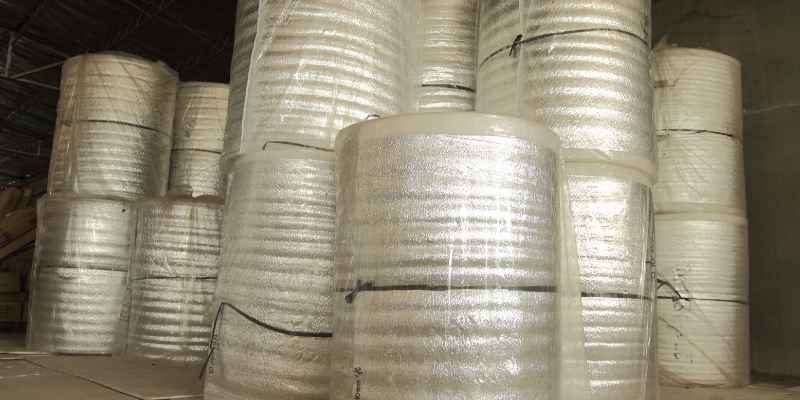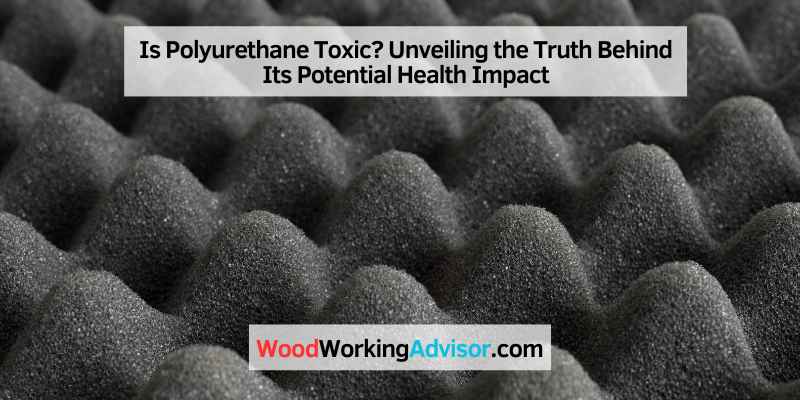Polyurethane can be toxic due to the release of harmful chemicals, such as isocyanates, during its production and application. While polyurethane is widely used in various industries, proper ventilation and protective measures should be taken to minimize the risk of exposure and ensure safety for humans and the environment.
Polyurethane is a versatile material commonly used in various industries and household products. It is found in items such as furniture, insulation, adhesives, clothing, and even automotive parts. However, concerns have been raised about the potential toxicity of polyurethane. During the production and application of polyurethane, chemicals called isocyanates are released.
These chemicals can cause respiratory problems, skin irritation, and in some cases, more severe health issues. Isocyanates are known to be toxic and have been linked to occupational asthma and other respiratory conditions. In order to minimize exposure to toxic compounds, it is important to ensure proper ventilation and appropriate safety measures are in place when working with polyurethane. This can include using protective equipment such as gloves, masks, and goggles. Considering the potential risks associated with polyurethane, it is crucial to handle and use this material with care to avoid harmful exposure and ensure the well-being of individuals and the environment.
What Is Polyurethane?
Polyurethane is a versatile material used in various industries, but is it toxic? While polyurethane itself is not inherently toxic, certain forms, such as spray foam insulation, may release potentially harmful chemicals during installation. It’s important to understand the specific type and application of polyurethane being used to assess any potential health risks.
Definition
Polyurethane is a versatile polymer that is formed by reacting a polyol (an alcohol with multiple hydroxyl groups) with a diisocyanate (a compound containing two isocyanate functional groups). It belongs to a class of polymers called thermosetting plastics, which means that they cannot be melted or reformed after they have been set.
Common Uses
Polyurethane is widely used in various industries, thanks to its unique properties and versatility. Here are some common applications:
- Furniture: Polyurethane foam is used in the manufacturing of comfortable cushions and upholstery for furniture.
- Flooring: It is often used as a protective coating for floors to enhance durability and resistance to wear and tear.
- Automotive: Polyurethane is used in the production of car interiors, such as seats, dashboards, and door panels, as well as in the manufacturing of tires.
- Construction: It is commonly used in insulation materials, sealants, adhesives, and coatings for buildings and infrastructure.
- Footwear: Polyurethane is a popular material for shoe soles due to its cushioning properties and resistance to abrasion.
- Appliances: It can be found in refrigerator insulation, refrigerator seals, and other components of home appliances.
These are just a few examples of the many applications of polyurethane. Its versatility and durability make it a valuable material in various industries.

Understanding The Concerns
Polyurethane is a commonly used material, but there are concerns about its toxicity. Understanding the potential risks involved can help individuals make informed decisions regarding its use.
With the growing awareness of the environmental impact of various materials, there has been a rising concern over the toxicity of polyurethane. What exactly does this mean for our health and the world around us? To shed light on this topic, we’ll delve into the potential health effects and the environmental impact of polyurethane.
Potential Health Effects
Polyurethane is commonly used in the production of numerous consumer goods such as furniture, flooring, and even mattresses. While it provides durability and versatility, some people worry about its potential impact on human health.
One of the primary concerns with polyurethane is the emission of volatile organic compounds (VOCs). These are chemicals that can be released into the air over time, leading to potential respiratory issues and irritating the eyes, nose, and throat. Children, the elderly, and individuals with pre-existing respiratory conditions may be more susceptible to these effects.
Furthermore, certain types of polyurethane foam contain flame retardant chemicals, such as polybrominated diphenyl ethers (PBDEs). These compounds have been linked to adverse health effects, including hormone disruption, neurodevelopmental issues, and even cancer.
While the potential health effects of polyurethane are cause for concern, it’s important to note that the degree of risk varies depending on factors such as the specific product, its composition, and the level of exposure. Regulatory bodies such as the Environmental Protection Agency (EPA) establish guidelines and limits to mitigate these potential risks.
Environmental Impact
Beyond its potential effects on human health, polyurethane also raises environmental concerns. The production process and disposal of polyurethane products involve various chemicals and resources that can have long-lasting effects on our ecosystems.
Polyurethane is typically derived from petroleum, a non-renewable resource. The extraction and refining of petroleum have a significant environmental impact, including habitat disruption, water pollution, and the release of greenhouse gases.
Additionally, the disposal of polyurethane products presents a challenge. Polyurethane foam, for example, is not easily biodegradable and can persist in landfills for many years. Incinerating polyurethane releases harmful emissions into the atmosphere, contributing to air pollution.
Several initiatives are underway to address these concerns and develop more sustainable alternatives. These include the promotion of recycling programs, the use of renewable raw materials, and the development of eco-friendly production processes.
In conclusion, understanding the potential health effects and environmental impact of polyurethane is crucial in making informed decisions about the products we use. By considering these aspects and supporting sustainable practices, we can strive for a healthier future for both ourselves and the environment.
Examining The Safety Measures
When it comes to the safety of products we use daily, having a thorough understanding of their composition is crucial. In the case of polyurethane, there are several safety measures in place to ensure the well-being of consumers. Let’s take a closer look at the regulatory standards and safety precautions surrounding polyurethane to address any concerns you may have.
Regulatory Standards
The safety of polyurethane is ensured through strict regulatory standards set by various governing bodies. These standards aim to limit the use of toxic substances and ensure that the material is safe for consumption and use. These regulations dictate the maximum allowable levels of potentially harmful chemicals in polyurethane products, making sure they meet the required safety benchmarks.
Here are some of the key regulatory standards for polyurethane:
| Regulatory Body | Standard |
|---|---|
| Environmental Protection Agency (EPA) | Restrictions on the use of certain additives |
| Occupational Safety and Health Administration (OSHA) | Guidelines for workplace exposure limits |
| European Chemicals Agency (ECHA) | Registration, Evaluation, Authorization, and Restriction of Chemicals (REACH) regulations |
Safety Precautions
Manufacturers of polyurethane take numerous safety precautions to ensure the material’s safety throughout its production, usage, and disposal. These measures are put in place to minimize potential risks and protect both workers and consumers.
Here are some of the safety precautions commonly employed:
- Strict adherence to regulatory standards
- Thorough testing of raw materials before production
- Implementation of safety protocols in manufacturing facilities
- Proper ventilation systems to minimize exposure
- Training programs for workers to handle and use polyurethane safely
- Appropriate labeling and instructions for consumers
- Eco-friendly disposal methods for waste polyurethane
With these safety measures in place, the risk associated with using polyurethane products is greatly mitigated. However, it’s essential to remain mindful of any potential allergies or sensitivities one may have, as individual reactions can vary.
Debunking Common Myths
One of the most common myths surrounding polyurethane is that it negatively affects indoor air quality. This belief stems from the misconception that polyurethane releases toxic fumes that can be harmful to breathe in an enclosed space. However, this is far from the truth.
Polyurethane is a type of plastic that undergoes a chemical reaction during its production process, transforming it into a durable and versatile material. Once polyurethane is fully cured, it becomes inert and does not emit any significant amount of harmful substances into the air.
In fact, polyurethane is considered to be a safe and low-emitting material, making it suitable for use in various indoor applications such as furniture, flooring, and coatings. It meets the stringent indoor air quality standards set by renowned organizations like GREENGUARD and LEED.
Polyurethane And Allergies
Another common myth is that polyurethane can cause allergies. While it is true that some individuals may have specific allergies or sensitivities to certain chemicals used in the production of polyurethane, the material itself is not inherently allergenic.
Polyurethane is formulated using a combination of chemicals, including isocyanates, which have the potential to cause allergic reactions in susceptible people. However, the vast majority of the population does not experience any adverse effects from polyurethane exposure.
Furthermore, manufacturers have taken significant steps to minimize the risk of allergic reactions by improving the safety measures during the production process. This includes utilizing advanced technology and equipment to control the release of potentially harmful substances and conducting thorough testing to ensure compliance with industry standards.
It’s also worth noting that once polyurethane is fully cured, the chances of experiencing allergenic reactions are greatly diminished. This means that the finished polyurethane products you encounter in everyday life, such as furniture or flooring, pose minimal risk of triggering allergies.

Alternatives To Polyurethane
Polyurethane, a commonly used material, has raised concerns about its toxicity. However, there are alternatives available that are non-toxic and eco-friendly. These include water-based finishes, natural oils, and wax-based coatings, which provide a safer option without compromising on performance or durability.
Natural And Non-toxic Materials
When considering alternatives to polyurethane, opting for natural and non-toxic materials is an excellent choice. These materials offer a safer and more environmentally friendly option for various applications.
- Plant-based oils: Vegetable oils, such as tung oil and linseed oil, can be used as finishes or sealants. These oils are derived from plants and provide a natural, non-toxic alternative to polyurethane.
- Wax: Natural waxes, such as beeswax or carnauba wax, can be used as a protective coating. They provide a chemical-free and safe option for preserving the natural beauty of wood.
- Shellac: Shellac is a natural resin obtained from the secretions of the lac bug. It has been used for centuries as a finish for wood and other surfaces. Shellac offers a non-toxic and eco-friendly alternative to polyurethane.
Eco-friendly Options
In addition to natural and non-toxic materials, several eco-friendly alternatives to polyurethane are available. These options prioritize sustainability and reduce environmental impact.
- Water-based finishes: Water-based finishes have gained popularity in recent years due to their low VOC (volatile organic compound) content. These finishes are less harmful to the environment and provide a safer option.
- Plant-based polyurethane: Some manufacturers offer polyurethane products made from plant-based sources, such as soybean oil. These alternatives retain the durability and protective properties of traditional polyurethane while reducing the reliance on petroleum-based chemicals.
- Natural resins: Various natural resins, such as dammar resin and pine resin, can be used as alternatives to traditional polyurethane. These resins are derived from trees and offer a sustainable and eco-friendly choice.
Conclusion
While there are potential health concerns associated with polyurethane, it is important to weigh the risks against the benefits. The key lies in being informed and taking necessary precautions. Opting for low-VOC or water-based polyurethane can minimize exposure. It is advisable to consult with professionals and follow safety guidelines when using polyurethane products.
Ultimately, by making informed choices, we can ensure the safety of ourselves and our environment.


